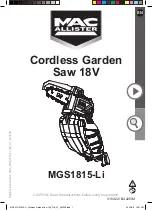
29
GB
13. Disposal and recycling
The equipment is supplied in packaging to prevent it
from being damaged in transit. The raw materials in
this packaging can be reused or recycled. The equip
ment and its accessories are made of various types of
material, such as metal and plastic. Defective compo
nents must be disposed of as special waste. Ask your
dealer or your local council.
Old devices must not be disposed of with house
-
hold waste!
This symbol indicates that this product must
not be disposed of together with domestic
waste in compliance with the Directive
(2012/19/EU) pertaining to waste electrical
and electronic equipment (WEEE). This product must
be disposed of at a designated collection point. This
can occur, for example, by handing it in at an author
ised collecting point for the recycling of waste elec
trical and electronic equipment. Improper handling
of waste equipment may have negative consequenc
es for the environment and human health due to po
tentially hazardous substances that are often con
tained in electrical and electronic equipment. By
properly disposing of this product, you are also con
tributing to the effective use of natural resources.
You can obtain information on collection points for
waste equipment from your municipal administration,
public waste disposal authority, an authorised body
for the disposal of waste electrical and electronic
equipment or your waste disposal company.
Batteries and rechargeable batteries do not be-
long in the household waste!
As the consumer you are required by law to
bring all batteries and rechargeable batteries,
regardless whether they contain harmful sub
stances* or not, to a collection point run by the local
authority or to a retailer, so that they can be disposed
of in an environmentally friendly manner.
*labelled with: Cd = cadmium, Hg = mercury, Pb =
lead
• Remove the batteries from the laser before dispos
ing of the machine and the batteries.
•
Kinks where the connection cable has been improp
erly fastened or routed.
•
Places where the connection cables have been cut
due to being driven over.
•
Insulation damage due to being ripped out of the
wall outlet.
•
Cracks due to the insulation ageing.
Such damaged electrical connection cables must not
be used and are lifethreatening due to the insulation
damage.
Check the electrical connection cables for damage
regularly. Make sure that the connection cable does
not hang on the power network during the inspection.
Electrical connection cables must comply with the ap
plicable VDE and DIN provisions. Only use connection
cables with the marking „H05VVF“.
The printing of the type designation on the connection
cable is mandatory.
AC motor
•
The mains voltage must be 230 V~
•
Extension cables up to 25 m long must have a
crosssection of 1.5 mm2.
Connections and repairs of electrical equipment
may only be carried out by an electrician.
Please provide the following information in the event of
any enquiries:
Type of current for the motor
•
Machine data type plate
•
Machine data type plate
















































